Announcing Our Lightning Desktop App, Now Available for Testing
by Olaoluwa Osuntokun
Today, we’re thrilled to be releasing a new cross-platform demo Desktop App for lnd. The release of this new demo wallet kicks-off a two-week “testing blitz” during which we hope Lightning users with a technical inclination can start testing the wallet, giving feedback, filing bugs, etc.
You can download the Lightning Desktop App from our official release on Github!
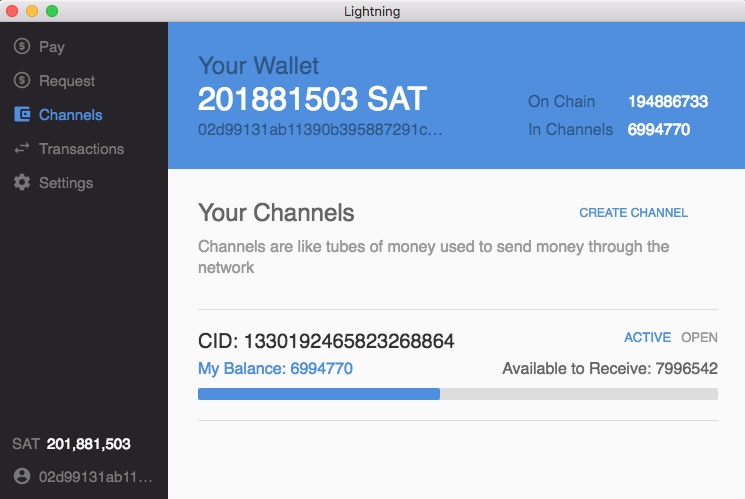
The Lightning Protocol specifications are nearly complete, however a breaking change may land before the specs are finalized. As a result, we’ll only be maintaining compatibility with the desktop application for approximately the next two weeks before switching to a regular release cycle once the specifications have been frozen and we’ve achieved cross-implementation compatibility.
Powered by Neutrino
The Lightning Desktop App is powered by neutrino, our new open
source, light client operating mode for Bitcoin. Neutrino light clients don’t
rely on bloom filters (BIP 37) as most light clients currently do. Instead,
neutrino relies on client side filtering which has numerous benefits
including: increased privacy, less active load on full nodes, and a more
flexible application model which is particularly useful for lightweight
Lightning nodes. The full technical details for neutrino can be found in our
soon to be finalized BIP draft.
With this new backend for lnd in place, users will be able to run Lightning
applications without having a synced full node, reducing the barrier to entry
for Lightning users.
Once you’ve unzipped and launched the Desktop App, neutrino will commence its
initial sync of Bitcoin’s testnet blockchain. Since the current testnet chain
has over 1.2 million blocks (over twice as many as Bitcoin mainnet), the
initial sync will take 10-15 minutes. A blue “Syncing to Chain” icon will flash
in the lower left corner until lnd has finished syncing the testnet chain.
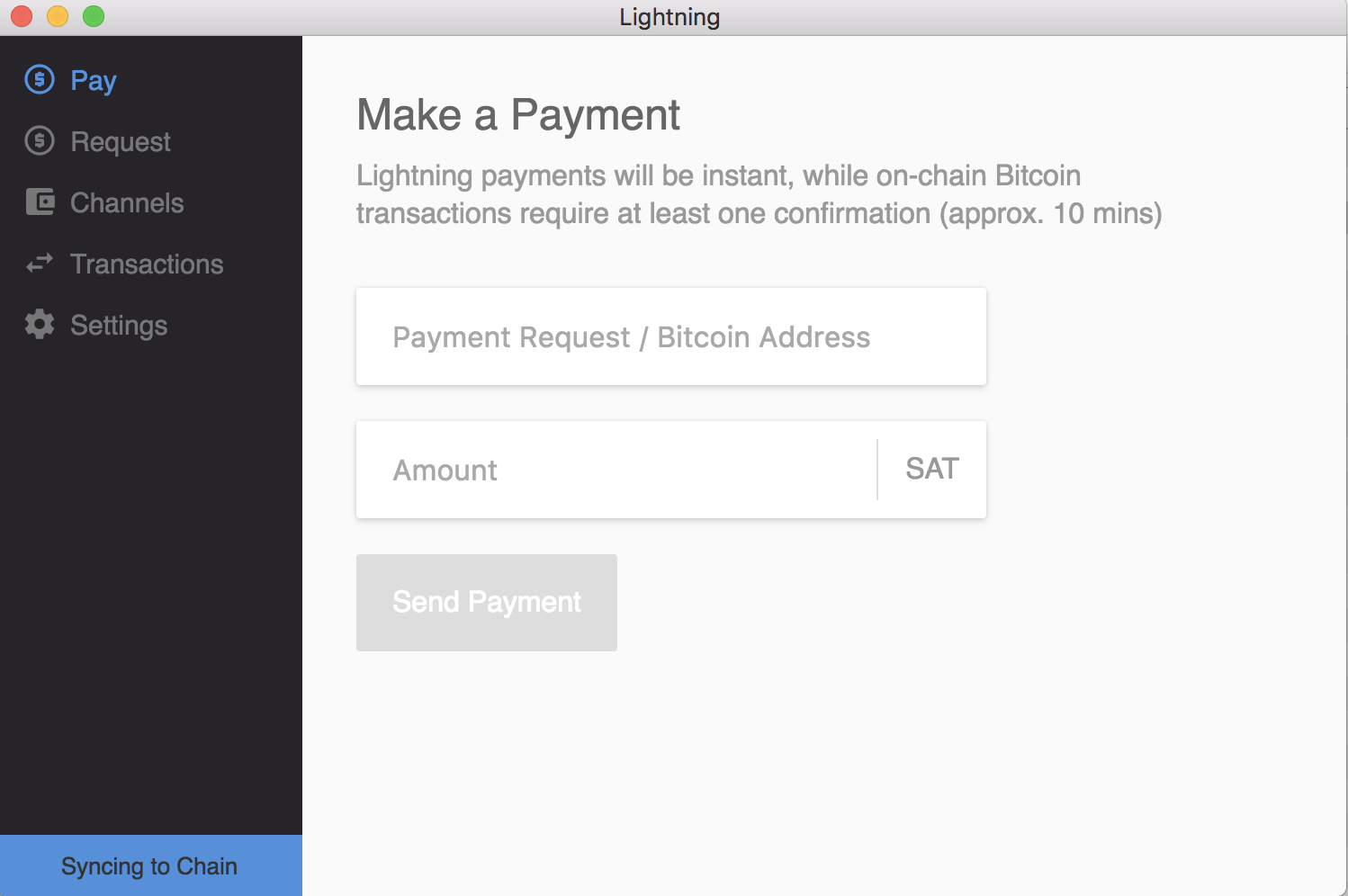
Segwit Enabled
The Desktop App is fully segwit enabled, capable of sending funds to and receiving funds from native segwit addresses, which look like:
tb1q62cgd0u7h654rpu4fm9y4fe47x5khesyd9k2q9
Note that in the Desktop App, for incoming payments, we currently display nested P2SH addresses. This format is used so that non-segwit enabled services (such as faucets) can send funds to the wallet. For outgoing funds, the wallet will only send to segwit outputs in order to prevent new channels from being subject to transaction malleability. Before proceeding, you’ll need to get your hands on some testnet coins! Testnet coins are available at faucets here and here.
Plug and Play Lightning
At a glance, the wallet may look very simple, but the bulk of the complexity
has been pushed into the backend in order to ensure a seamless user experience
when interacting with Lightning. Once lnd is fully synced, p2p connection
bootstrapping combined with lnd’s autopilot will kick into action,
automatically making the wallet truly plug-and-play.
P2P Connection Bootstrapping
Once lnd has fully synced, it will attempt to automatically establish
connections to existing peers on the network in order to sync the latest
channel graph state. After a sufficient number of connections has been
established, the next phase of the wallet’s network initialization will kick
off. Users will know the wallet is fully synced to the chain, as the “Syncing
to Chain” icon will disappear, replaced with the public key of your new
Lightning node.
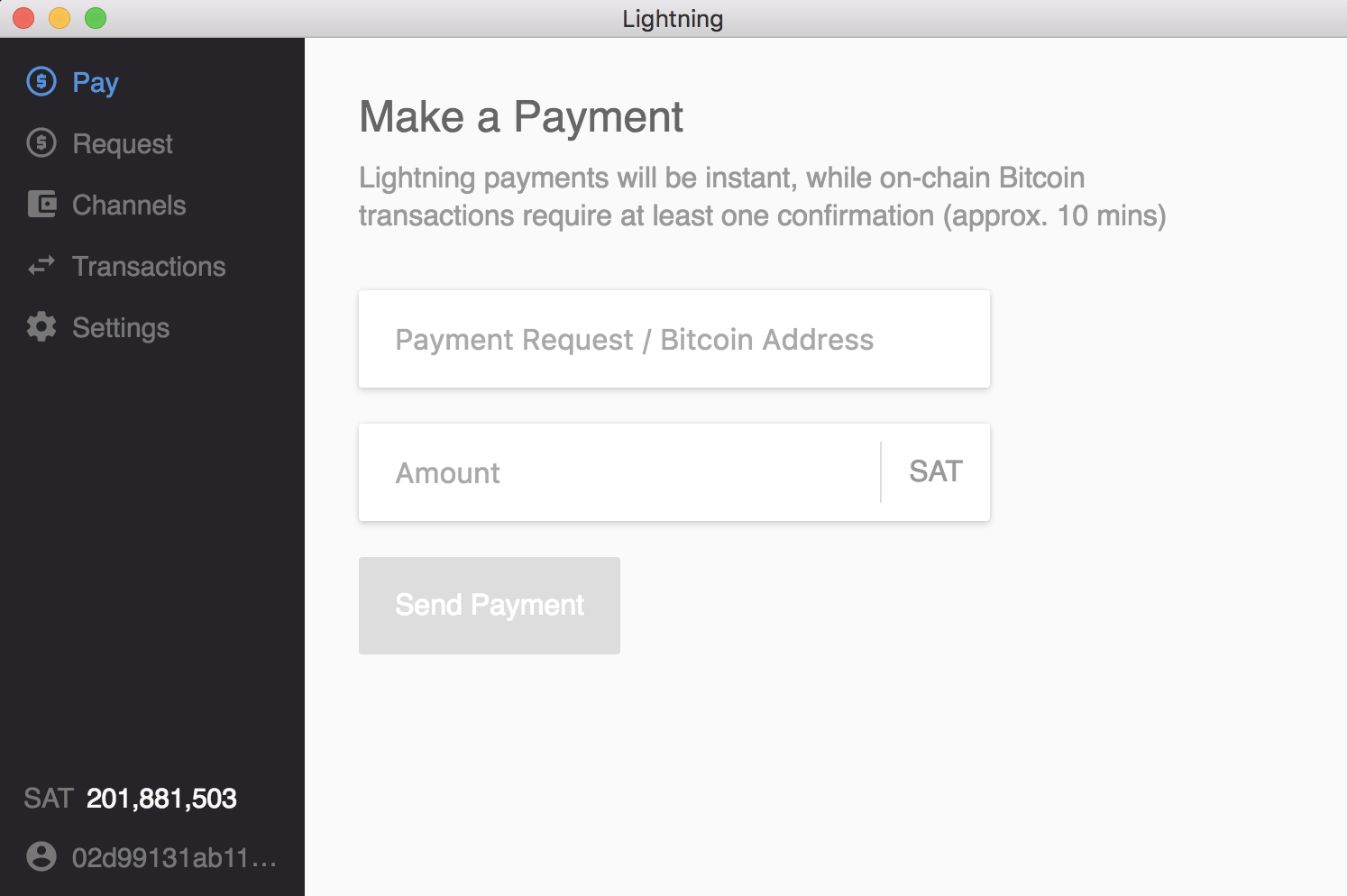
autopilot: Self-Driving Lightning
The latest build of lnd comes equipped with a new experimental option for
any planned flavors of automatic channel
management,
meaning users won’t necessarily need to manually establish channels. We call
this new operating node autopilot as it will automatically manage the opening
of channels within the network.
autopilot is essentially a closed-loop control system: it takes inputs such
as the number of channels opened, time when channels are closed, and changes to
the wallet’s balance. Once those signals are received, it consults a set of
heuristic to decide if it needs more channels, and if so, to whom those
channels should be opened. The Agent then carries out the recommendations of
its heuristics.
Once your wallet is loaded with testnet coins, you’ll start to see autopilot
at work on the Channels page. The autopilot agent will begin opening
channels driven by its heuristics. This process also helps drive the network
graph toward a scale-free topology.
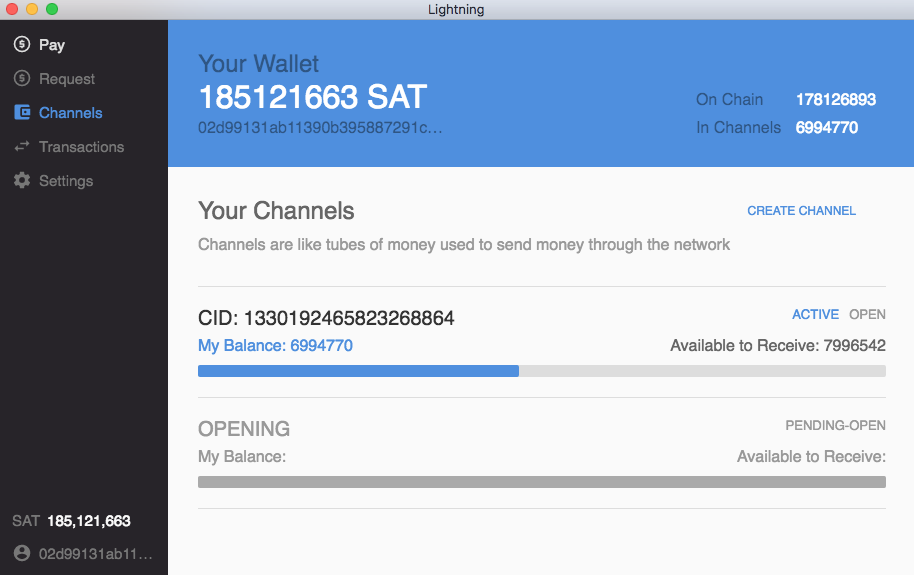
Channels are shown in two statuses: PENDING-OPEN, and ACTIVE. The PENDING-OPEN stage indicates that the funding transaction has been broadcast, but is still awaiting confirmation on the blockchain. The ACTIVE status indicates that a channel is fully open and ready to send and receive payments.
Interacting With Live Network Applications
For sending/receiving funds over Lightning, the wallet implements BOLT-11 which defines an extensible invoicing protocol for Lightning payments. Using this encoding, a standard payment request to receive funds over Lightning looks like:
lntb4200n1pvaue4ypp5k86jth0zefkje0u88ftmp37rvy64p8fl5el7jla0cgn3av6nhmpsd8s0v3xzun5d93kce2ld9jzyw3zxy6nsefev93kyttp8psnwtf5xycrwttpxu6nyttz8p3rvv3jxpsnyerzxg3zcgnyv4ekxunfwp6xjmmwygazy5n9v9jzqstjw35kxmr98gs9y3f6yp28yctwwdskxarfdah8xgrpdejzq5mrwf5hqarn8gsyg42sypyyz56gxymrqgpw9chzq32324q5c4j92fy5vkfqgdyy2s6t2dy5wgnayhq8y6pw5957tqn374jczramqyzjr8f7vt7v3m2shtqgcnp9u538fv27zp2egju5uljscyuvul5n86kg0670zf68q4a09kcnzcyjgyqprd5d5p
This particular request is from the
ln-articles Lightning app (Lapp) created
by Alex Bosworth which implements an
article publishing site with a micropayment paywall. If we go to the command
line to decode the payment request, we’ll see that we’re about to pay for a
hosted
article.
$ lncli decodepayreq --pay_req=lntb4200n1pvaue4ypp5k86jth0zefkje0u88ftmp37rvy64p8fl5el7jla0cgn3av6nhmpsd8s0v3xzun5d93kce2ld9jzyw3zxy6nsefev93kyttp8psnwtf5xycrwttpxu6nyttz8p3rvv3jxpsnyerzxg3zcgnyv4ekxunfwp6xjmmwygazy5n9v9jzqstjw35kxmr98gs9y3f6yp28yctwwdskxarfdah8xgrpdejzq5mrwf5hqarn8gsyg42sypyyz56gxymrqgpw9chzq32324q5c4j92fy5vkfqgdyy2s6t2dy5wgnayhq8y6pw5957tqn374jczramqyzjr8f7vt7v3m2shtqgcnp9u538fv27zp2egju5uljscyuvul5n86kg0670zf68q4a09kcnzcyjgyqprd5d5p
{
"destination": "028c620eb95c3907a779adf9c47612973b70c322e5b60a21886947867439ff63e6",
"payment_hash": "b1f525dde2ca6d2cbf873a57b0c7c36135509d3fa67fe97fafc2271eb353bec3",
"num_satoshis": "420",
"timestamp": "1507747492",
"expiry": "3600",
"description": "{\"article_id\":\"158e9acb-a8a7-4107-a752-b8b6220a2db2\",\"description\":\"Read Article: RE: Transactions and Scripts: DUP HASH160 ... EQUALVERIFY CHECKSIG\"}",
"description_hash": "",
"fallback_addr": ""
}
If you look closely, the payment request includes the target node, the payment hash, the amount of the payment, and a description for the user. These values all correspond to making a micropayment to view the remainder of the article on LN Articles:
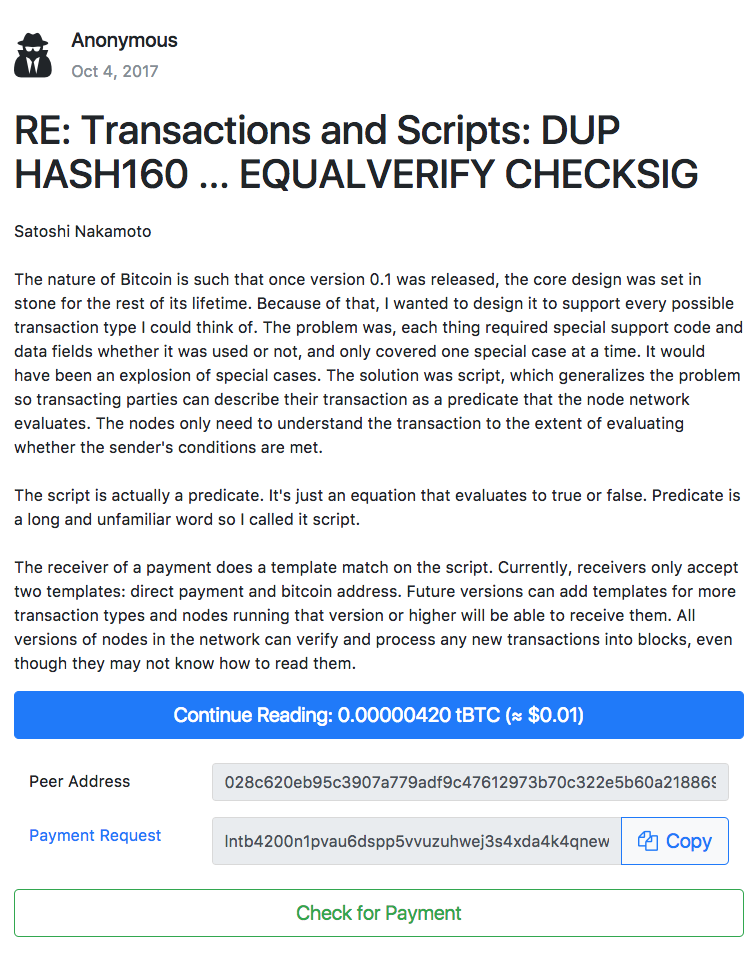
Once we paste the payment request into the wallet, it’ll automatically parse the payment request and display the value of the invoice in the UI.
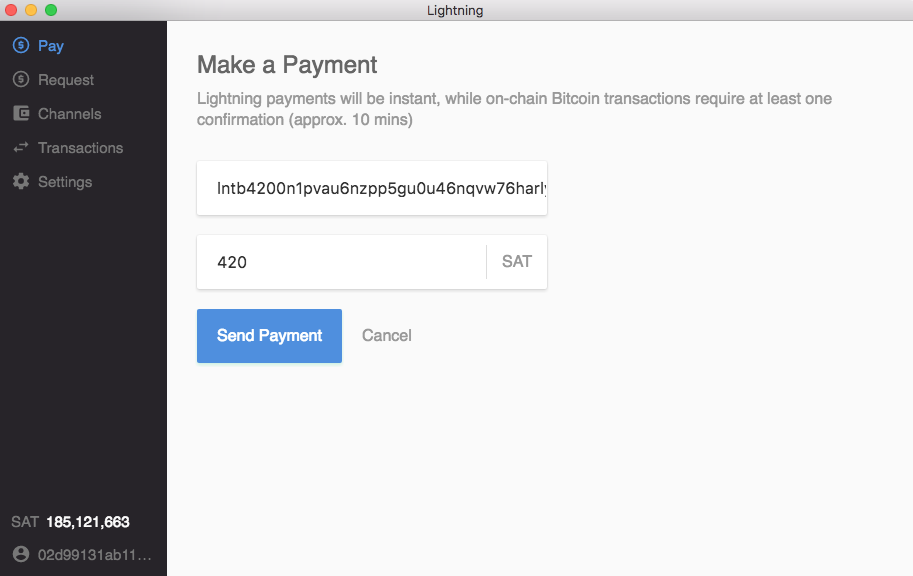
If we click send, the payment will be routed over the network to the
Lightning node which backs the LN Articles paywall!
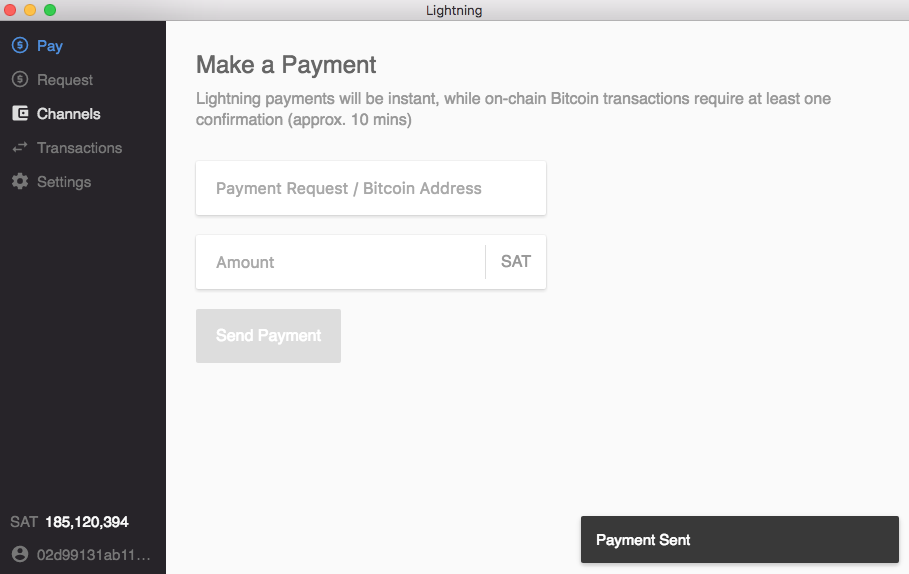
As this is a fully fledged wallet, it’s also possible to make regular on-chain payments using the same page. The wallet will automatically detect if it is presented with an on-chain Bitcoin address or a Lightning payment request.
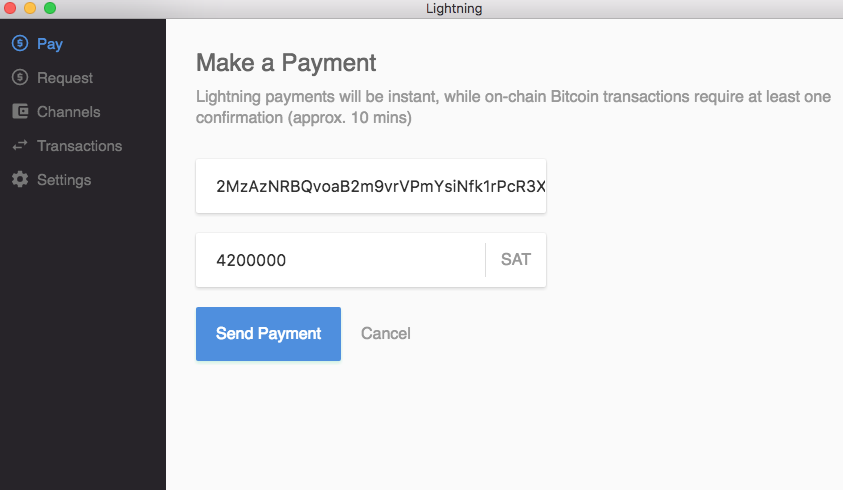
Let the Testing Commence!
We encourage technical users to download the wallet for their target operating
system and start experimenting with Lightning. Developers may be interested in
the current gRPC and HTTP-REST API for lnd,
and also our lnd Developer Resources which
contains tutorials, example applications, and other resources for understanding
the application model of Lightning development.
In addition to the LN Articles paywall, several other application/integration demos are live on testnet such as the Bitcoin Testnet Lightning Faucet, Custodial and Bitrefill’s top-off demo.
Any questions/comments can be directed at our active slack community.
The source code for the application is public on Github, and can be found here. Contributors welcome!
Finally, you can download the Lightning Desktop App from our official release on Github!
